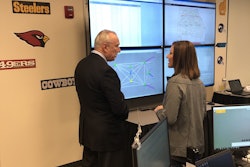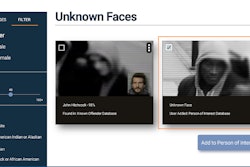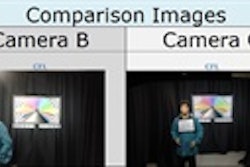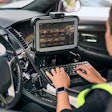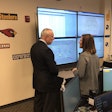One of the fastest-growing trends in law enforcement technology is the addition of unmanned aerial sytems (UAS)—commonly referred to as "drones"—to the vehicle fleet.
Once really just recreational "toys," drones have taken on serious roles in a variety of businesses. In farming, they can survey vast areas of crops. Drones have become vital in the film-making business, saving production studios the cost of renting helicopters.
Drones are even being considered for delivery services from online stores and local restaurants.
For police, drones are ideally suited for search-and rescue missions, collecting reconnaissance data of a scene where a wanted suspect is thought to be hiding, and photographing/mapping crime scenes, or the scene of a natural or man-made disaster in which toxins may be present. A drone can be flown into the window of a residence where a gunman has taken hostages to surveille the area before SWAT team members make entry. A drone can be flown over a public protest that devolves into a disturbance/riot to identify the people causing the mayhem amidst the crowd.
There has been an explosion of manufacturers getting into the drone market specifically designed for police missions. The market is crowded with choices—tough choices—for police commanders to decide upon. Here are several things to consider when making the decision to add a drone to your agency's capabilities.
Setting Mission Parameters
What do you want your drone to do for you? There are several "general purpose" designs but there are also models available that are specifically designed for certain missions. Commanders should come to agreement on the scope of the use of the asset, outline a plan, and then begin contacting manufacturers to see what they have to offer.
Developing Policies and Procedures
Once you've determined what you want out of your drone program, you must then develop polices and procedures to add to the long row of three-ring binders in the squad room and at the training academy. There are model policies available from a variety of sources—from the IACP to the NTOA and even some state legislatures.
Getting Licensed by the FAA
Just like your 16-year-old kid cannot just hop in your personally owed vehicle and go for a cruise without first getting their driver's license from the DMV, police agencies cannot just launch a drone program with out getting clearance from the FAA. Also, any officers who are going to be operating the system need to be licensed by the FAA. The FAA has a special office—the Law Enforcement Assistance Program (LEAP)—specifically set up to address questions and concerns for commanders who are creating a drone program.
Purchase Price and Operational Cost
This is a no-brainer. With police budgets in so many places being cut—"defunded"—the purchase price and expected operational costs are a vital element for command staff to consider when adding a drone to the agency's assets. There are drones that are relatively simple and inexpensive, and there are options that when you look at the price tag your eyes might pop out of your head. Remember also to look carefully at your opportunities for receiving grant funds. If you have access to a great grant-writer, put them to work on matching your interest in launching the operation with programs at the COPS Office or elsewhere.
Training, Training, Training
Last but not least, your officers need to be well trained—the operators will of course be receiving training in order to receive the FAA certificate. But every officer in the agency should be trained in how to leverage the aircrafts' capabilities, and remain in compliance with the policies and procedures you wrote at the beginning of the process. It would also be a good idea to have an instructor at the police academy also get their drone pilot's license, so they are conversant with the do's and don'ts of drone operation for public safety.
Final Thoughts
Drones are fantastic machines. They have capabilities other air assets don't have. They will never replace the police rescue helicopter because they don't the lifting power to pull an injured person in a basket out of the woods and fly them to a nearby hospital. But they can fly beneath the canopy of that wooded area in search of the victim, locate that individual, and guide that police helicopter to the location.
Police use of drones is growing, and as your agency begins to consider joining the trend, please consider some of these little pieces of information before taking to the skies.






